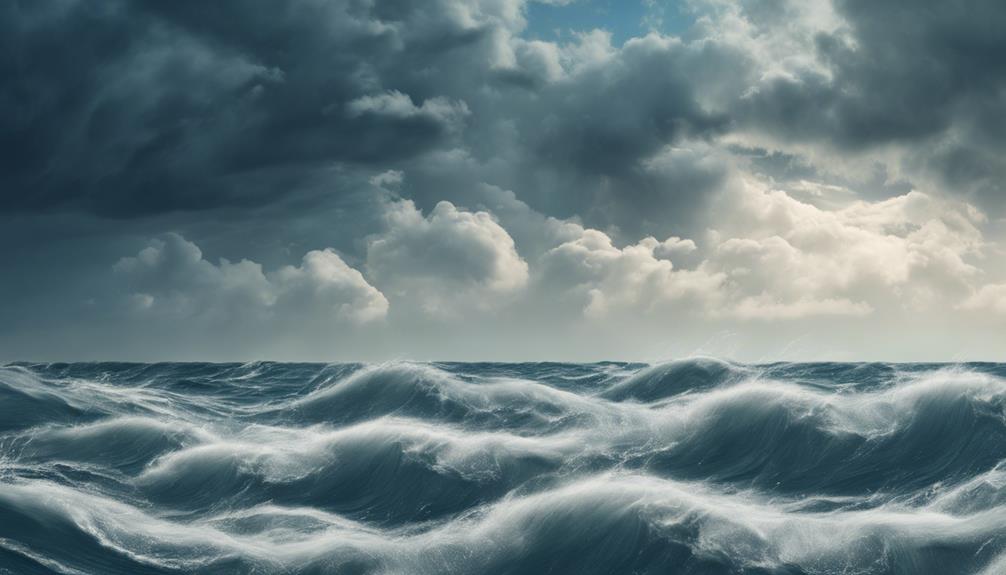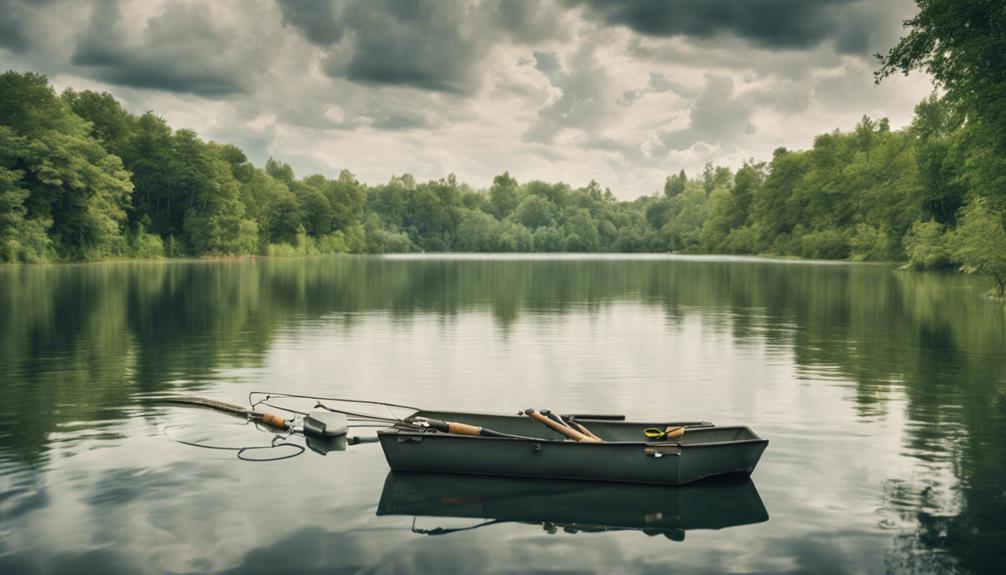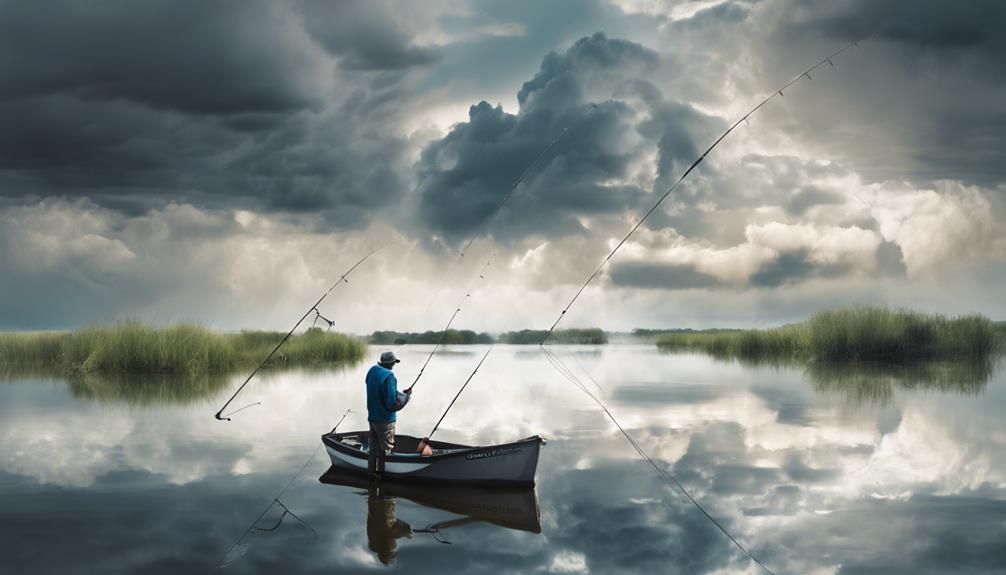Weather patterns significantly impact your fishing success. Factors like wind direction, water temperature, barometric pressure, cloud cover, rainfall effects, moon phases, and utilizing weather forecasts all play crucial roles in determining your catch rates and angling outcomes. Adapting your strategies to these variables can greatly enhance your chances of success. Understanding how these elements interact with fish behavior and habitat preferences is key to becoming a more successful angler. Each factor offers unique insights into optimizing your fishing experience.
Importance of Weather Patterns in Fishing
Understanding how weather patterns impact fishing success is crucial for anglers seeking to increase their catch rates. Seasonal variations play a significant role in determining the behavior of fish, affecting their feeding habits and movement patterns. Different seasons bring about changes in water temperature, which in turn influence the distribution of fish species. For instance, during the warmer months, fish tend to move closer to the surface to feed, while in colder months, they may seek deeper waters. Adjusting your fishing strategies according to these seasonal variations can greatly enhance your chances of a successful catch.
Climate changes also have a substantial impact on fishing outcomes. Shifts in climate can lead to alterations in fish populations and their preferred habitats. For example, rising water temperatures due to climate change may cause certain species to migrate to cooler waters, affecting their availability to anglers. Understanding these changes and adapting your techniques accordingly is crucial for maintaining consistent fishing success. By staying informed about the weather patterns and how they influence fish behavior, you can optimize your fishing trips and improve your overall catch rates.
Understanding Wind Direction for Fishing
Examining wind direction is essential for optimizing fishing success as it directly influences fish behavior and feeding patterns. When considering wind speed, it's crucial to note that moderate winds can stimulate fish activity by oxygenating the water and creating a natural drift that carries bait to the fish. However, excessively strong winds can disrupt feeding patterns as fish seek shelter in calmer waters.
In terms of casting techniques, understanding wind direction allows anglers to position themselves advantageously. Casting against the wind can provide greater accuracy and distance, while casting with the wind can help cover more water efficiently. Adjusting casting angles according to wind direction can significantly improve the chances of enticing a strike.
Moreover, wind direction plays a vital role in relation to tides. Crosswinds can cause choppy waters and affect the movement of bait, influencing where fish position themselves. By aligning casting angles with the wind and tidal flow, anglers can strategically present their bait for optimal results.
When selecting bait, considering wind direction is equally important. Certain baits may be more effective when presented against the wind due to the way they move through the water. By matching bait selection with wind direction, anglers can enhance the attractiveness of their offering and increase the likelihood of a successful catch.
Impact of Temperature on Fish Behavior
Considering the influence of weather patterns on fishing success, the impact of temperature on fish behavior is a critical factor to analyze for optimizing your angling strategies. Water temperature plays a significant role in determining fish behavior. In warmer waters, fish tend to be more active, leading to increased feeding patterns. Conversely, colder temperatures can slow down fish metabolism, resulting in reduced activity levels and feeding behaviors.
Moreover, temperature influences water clarity, affecting visibility for both fish and anglers. Changes in water temperature can cause shifts in water density, impacting the clarity of the water. Fish may respond to variations in water clarity by adjusting their behavior, such as becoming more cautious or aggressive in their feeding habits.
Additionally, temperature directly influences oxygen levels in the water. Warmer water holds less dissolved oxygen than cooler water, which can affect fish respiration and overall activity. Understanding how temperature fluctuations impact oxygen levels is crucial for predicting fish movements and feeding patterns.
Furthermore, temperature plays a crucial role in fish spawning behavior. Different fish species have specific temperature preferences for spawning, with some requiring warmer water temperatures to initiate the spawning process. Monitoring temperature changes can help anglers anticipate spawning seasons and target specific fish species more effectively. By considering the impact of temperature on fish behavior, anglers can enhance their fishing success by aligning their strategies with the prevailing environmental conditions.
Effect of Barometric Pressure on Fishing
Barometric pressure significantly influences fish behavior and can serve as a predictive indicator for fishing success. Changes in barometric pressure affect fish in various ways, prompting alterations in their feeding habits and movement patterns. When the barometric pressure is high, fish tend to move towards deeper waters, becoming less active and more sluggish. Conversely, during low-pressure systems, fish often move to shallower areas and are generally more active, making them easier to catch.
Understanding the impact of barometric pressure on fish behavior allows anglers to adjust their fishing techniques accordingly. When the pressure is high, consider using slower presentation methods and focusing on deeper fishing spots where fish may be congregating. In contrast, when the pressure is low, opt for faster retrieval speeds and target shallow areas where fish are likely to be more active.
Monitoring pressure changes can provide valuable insights into the optimal times for fishing. A falling barometer, indicating an approaching low-pressure system, can signal increased fish activity, presenting a prime opportunity for a successful fishing outing. Conversely, a rising barometer may suggest that fish will be less active, requiring a strategic approach to lure them effectively. By incorporating knowledge of barometric pressure into your fishing strategy, you can enhance your chances of a fruitful fishing experience.
Role of Cloud Cover in Fishing Success
Cloud cover plays a crucial role in determining fishing success by influencing fish behavior and habitat preferences. The movement of clouds across the sky affects the amount of sunlight reaching the water's surface. Cloud cover can impact fish visibility, as varying densities of clouds alter the levels of light penetration into the water.
Fish are highly sensitive to changes in light conditions. On sunny days with minimal cloud cover, sunlight penetrates the water, allowing fish to see more clearly and potentially making them more cautious. Conversely, on overcast days with thick cloud cover, sunlight penetration is reduced, creating darker conditions that can make fish feel more secure and encourage them to venture into shallower areas to feed.
Additionally, cloud cover can influence fish activity levels. Fish that are more light-sensitive may become more active during low light conditions, such as when clouds obscure the sun. This can lead to increased feeding behaviors and more opportunities for successful fishing. Conversely, fish species that prefer brighter conditions may become less active or move to deeper waters when clouds block out the sunlight.
Understanding the role of cloud cover in fishing success is essential for anglers looking to optimize their chances of a good catch. By paying attention to cloud movement and its effects on fish behavior, anglers can adapt their fishing strategies to suit the prevailing weather conditions.
Significance of Precipitation in Fishing
How does precipitation impact fishing success?
Precipitation plays a significant role in determining the outcome of a fishing trip. Understanding the effects of rainfall on fish activity can help anglers adapt their strategies for a more successful fishing experience.
- Rainfall Effects:
- Heavy rain can cause water levels to rise rapidly in rivers and streams, leading to increased water flow that can displace fish from their usual spots.
- Fish Activity:
- Some fish species become more active during light rain as it can wash insects into the water, providing them with an easy food source.
- Precipitation Patterns:
- Anglers need to monitor precipitation patterns to anticipate changes in fish behavior. Fish are often more active before a storm but may become less active during heavy rain.
- Angler Strategy:
- Adjusting fishing techniques during and after precipitation can improve success rates. Using artificial lures that mimic insects washed into the water can be effective during light rain.
- Water Clarity:
- Rainfall can affect water clarity, making it harder for fish to see bait. Anglers should consider using brighter or noisier lures in murky water to attract fish.
Influence of Moon Phases on Fishing

The influence of moon phases on fishing success is a well-documented phenomenon that impacts the behavior of various fish species. Understanding the relationship between lunar cycles and fishing outcomes is essential for optimizing your fishing trips.
During different moon phases, such as the new moon and full moon, fish tend to exhibit varying levels of feeding activity. For example, around the new moon, when the moon isn't visible in the sky, fish may be less active and feeding less. In contrast, during the full moon, when the moon is bright and full, fish may be more active and feeding more aggressively.
Moreover, moon phases also influence tidal movements, which significantly affect fishing outcomes. Tides are primarily caused by the gravitational pull of the moon on the Earth's oceans. During high tide, nutrient-rich water is brought closer to the shore, attracting baitfish and predators. This makes high tide an optimal time for fishing, as predatory fish are more likely to be actively feeding in these areas.
Utilizing Weather Forecasts for Fishing
Weather forecasts play a pivotal role in determining optimal fishing conditions and enhancing overall fishing success. When utilizing weather forecasts for fishing, it's essential to consider several key factors:
- Tackle Selection: Weather forecasts help you choose the right tackle for the conditions you're likely to encounter. For example, if high winds are predicted, opting for heavier lures or sinkers can help you cast more effectively.
- Fishing Strategy: Understanding weather patterns allows you to adjust your fishing strategy accordingly. If a cold front is approaching, knowing that fish tend to be more sluggish can help you slow down your retrieval speed to entice bites.
- Wind Direction: Knowing the forecasted wind direction can be beneficial. Fish often gather in areas where food is carried by the current, so casting upwind can increase your chances of attracting bites.
- Barometric Pressure: Weather forecasts provide valuable information on changes in barometric pressure. Falling pressure can lead to increased fish activity, while rising pressure may cause fish to be less active.
- Precipitation: Being aware of precipitation forecasts enables you to plan for potential changes in water clarity and fish behavior. Rain can wash nutrients into the water, attracting fish to feed.
Frequently Asked Questions
How Does Water Clarity Affect Fishing Success?
When fishing, water clarity directly impacts your success. Clear water allows fish to see your bait more easily, so you may need to adjust your techniques.
Temperature fluctuations affect fish behavior, making them more active in certain conditions.
Wind speed can also play a role, influencing how you should approach your fishing strategy.
Understanding these factors can help you adapt and increase your chances of a successful fishing trip.
Can Underwater Currents Impact Fishing Opportunities?
Underwater currents play a crucial role in influencing fish behavior and ultimately impacting fishing opportunities. These currents can affect the movement of baitfish, which in turn attracts larger predatory fish.
Understanding how underwater currents shift and flow can help anglers strategically position themselves to maximize their chances of catching fish.
What Role Does Air Pressure Play in Fishing?
When considering the role of air pressure in fishing, temperature fluctuations and barometric pressure are key factors to understand. Changes in air pressure can affect fish behavior and feeding patterns.
Low pressure often leads to increased fish activity, while high pressure can make fish more sluggish. Wind speed can also impact fishing success, influencing water currents and bait presentation.
Adapting fishing techniques to match these weather conditions can significantly improve your chances of a successful catch.
Do Tidal Movements Affect Fish Feeding Habits?
When considering tidal behavior and its impact on fish feeding preferences, it's crucial to understand the intricate relationship between these factors.
Tidal movements play a significant role in dictating fish behavior, influencing their feeding habits and locations.
As tides fluctuate, they can affect the availability of food sources for fish, leading to changes in their feeding patterns.
Is There a Connection Between Fishing Success and Lightning Storms?
When fishing, it's crucial to consider safety precautions and equipment preparation, especially when faced with lightning storms. Lightning detection and emergency protocols are essential for your well-being. Remember, your safety comes first.
Be aware of the risks associated with fishing during lightning storms and take necessary steps to ensure you're protected. Stay informed, follow safety guidelines, and prioritize your well-being above all else.
Conclusion
In conclusion, weather patterns play a crucial role in fishing success. Wind direction, temperature, barometric pressure, cloud cover, precipitation, and moon phases all impact fish behavior and feeding patterns.
By understanding these weather factors and utilizing weather forecasts, anglers can increase their chances of a successful fishing trip.
It's important to consider these variables when planning your next fishing excursion to maximize your chances of a productive outing.



